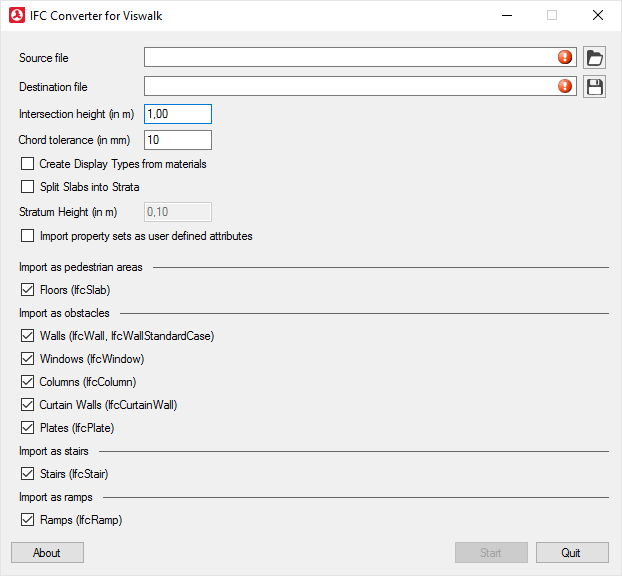Starting conversion in Viswalk
Converting an *.ifc file to an *.inpx file may take several minutes depending on the data volume. The conversion is run in the external IFC2INPX_GUI.exe application. It is not run in Viswalk. This allows you to continue to work in Viswalk during the conversion process. IFC2INPX_GUI.exe is stored to the ..\IFC2INPX directory of your Viswalk installation.
1. On the File menu, click > Import > BIM (*.ifc).
The IFC Converter for Viswalk window opens.

2. Make the desired changes:
| Element | Description |
|---|---|
|
Source file |
*.ifc file that is to be converted to an *.inpx file. |
|
Target file |
*.inpx file that is created by a conversion |
|
Intersection height (in m) |
The height above each imported level that runs in parallel to the base area in which Viswalk checks the building model's vertical subcomponents in terms of openings in order to identify window/door openings and obstacles. Default 1.00 m |
|
Chord tolerance (in mm) |
Viswalk uses polygons for modeling circular objects in IFC. The chord tolerance value specifies the maximum distance between the edges of the polygon and the actual circle before creating an additional corner point. Default 10.00 mm |
|
Creating display types using materials |
Creating a display type using each material imported. |
|
Stratifying slabs |
Modeling sloped ceilings or floors based on the BIM by stratifying the resultant pedestrian areas. Multiple pedestrian areas with different Z-coordinates are created. The attribute Stratum height (in m) defines the vertical distance. |
|
Stratum height (in m) |
Stratum height for floors above the base area. Default 0.10 m |
|
Imported property sets as user-defined attributes |
Creating user-defined attributes based on the IFC property sets. |
|
Import as pedestrian areas |
Floors (IfcSlab): Selecting floors to create construction elements based on the network object type pedestrian area. |
|
Import as obstacles |
Selecting the following subcomponents to create construction elements based on the network object type Obstacles:
|
|
Import as stairs |
Stairways (IfcStair): Selecting stairs to create construction elements based on the network object type Stairs. |
|
Import as ramps |
Ramps (IfcRamp): Selecting ramps to create construction elements based on the network object type ramps. |
|
About |
information on IFC2INPX, the software used and contact details |
|
Start |
Starting conversion to the *.inpx file |
3. Import the network file (Importing INPX files including building data).
Superordinate topic:

